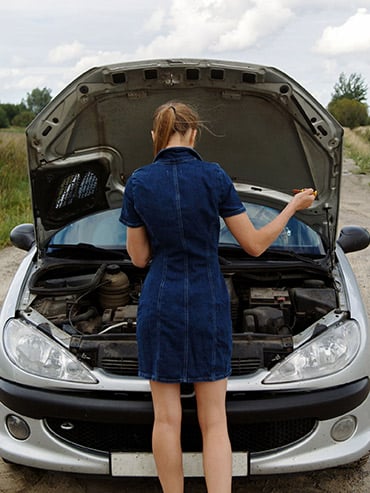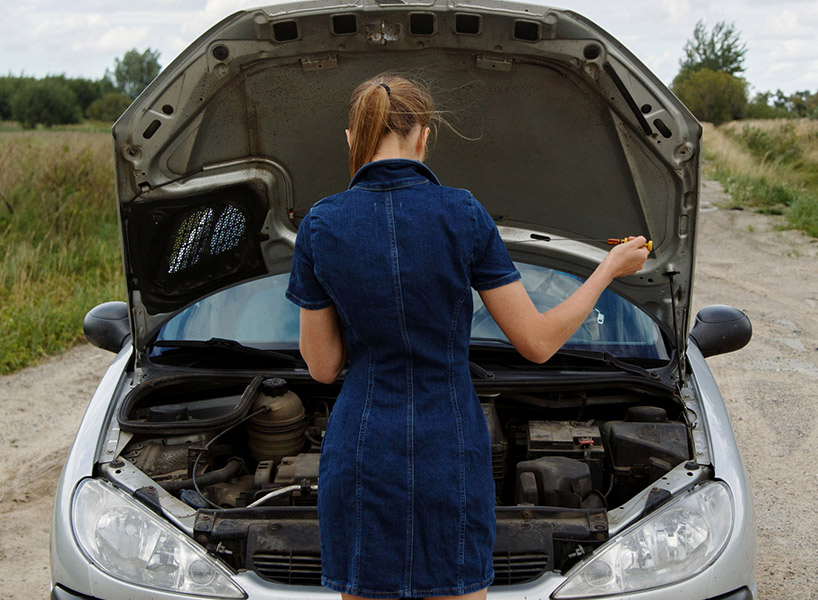You Got This: How to Change a Flat Tire (and Other Car Emergencies)
Dead battery? Fender bender? It might be tempting to pull over and cry (and that’s OK, too) but you can totally handle this, trust

In partnership with Surex

In the 14 years my beloved (but ancient) Toyota Highlander and I have been together, we’ve been through…A LOT. There was the time my brother backed into my parked car with considerable speed. Or the time *I* backed into someone else’s bumper, costing me $2,000 and my pride. I’ve white-knuckled it to my mechanic when a scary red icon randomly lit up on my dash. I’ve needed a tow, and I’ve been towed.
That’s the thing about being a driver: It’s not all cruising along the highway, windows down, belting out “Old Town Road.” Sometimes it’s your fault, and sometimes it’s just life—or, you know, your idiot sibling—but car emergencies will happen to all of us. So, learning how to deal is clutch. (And, honestly, you’ll feel pretty badass the first time you realize you can fix this without calling your dad/brother/boyfriend/therapist.) Having this basic knowledge is basically another form of car insurance: You hope you’ll never need it, but you’ll be *so relieved* to have it when you do.
What to do when: You have a flat tire
“Don’t panic and don’t slam on the brakes,” says Jessica Mammoliti, a licensed auto mechanic in Richmond Hill, Ont. “Put your emergency flashers on, and slowly merge to safety.” The key here is to drive as short a distance as possible—the longer you go, the more risk of damage to things like your rims or axel, which can be mega pricey to fix—and find a protected (and populated) place to change the tire, like a parking lot. Go into your trunk and pull out your jack, tire iron, and your spare tire. This will just be a temporary fix to get you to the nearest service station so don’t, like, plan to continue on your epic cross-country road trip from here. Tools in hand, here’s your step-by-step guide, courtesy of Mammoliti:
- “Loosen your wheel nuts about half a turn, and then place your jack under your car on a flat surface. There’s a lip under your car below the car door; that’s your lift point, about a foot away from the wheel.” (This is important! Lifting from the wrong point will do bad things to your car, apparently.)
- “Lift the vehicle about two inches off the ground and remove the flat tire. Place the spare on the wheel hub and tighten the nuts just with your hand.”
- “Softly lower the vehicle, and when it’s completely on the ground, tighten the wheel nuts with the tire iron. You don’t need to jump on the iron—just put some good elbow grease into tightening them. And that’s it!”
If you can’t get to a safe place or just don’t feel comfortable attempting this, don’t stress. There really is no shame in asking for help, and there are people employed to do just that. “Call roadside assistance,” says Mammoliti. “They’re specialists trained to help you.”
What to do when: You get into a fender bender
YIKES. A distracted driver on their phone just drove into you at a red light. You’re shaken but otherwise fine… you think? “Never just assume you’re OK because you feel OK [in] the moment,” says Mary Greene, automotive services technician and professor at Centennial College. It’s important to go get checked over by your doctor—not doing so might affect your ability to make an insurance claim. Your first step, however, is to put on your four-ways, and pull over to the right, if possible. “Hopefully the other driver cooperates,” Greene says, “and you’re both off on the shoulder where you can exchange insurance information.” Now’s also the time to call an emergency service, if you need it. If possible, go directly to the collision reporting centre nearest you, where you and the other driver can establish who is at fault. And if you’re freaking out about how this is going to affect your car insurance rates, remember that many policies include “accident forgiveness” for first time offenders.
What to do when: Your car has overheated
Is the temperature gauge at over ¾? Do you hear a loud dinging noise? Maybe see some steam? Chances are your car is overheating. Do not keep driving! Pull over safely, turn your engine off and pop that hood. If you’re carrying coolant in your trunk (which you totally should), wait until your car is cool and top up the coolant reservoir to the max. Proceed directly to your mechanic. Related note: Checking your fluids is an essential part of routine maintenance—and, like, the epitome of adulting.
What to do when: Your car battery is dead
You left your headlights on all.dang.night. and your battery is dead. Fear not, friend. First, locate someone with a working battery and a set of jumper cables. (Make a new friend! Meet your neighbours!) Greene says to get them to pull the front of their car as close as possible to the front of yours, and then connect the red cable from the positive terminal of the running battery to the positive terminal of your dead one. (It’ll be marked with a plus sign, or have a red case or cover. It’s also the larger terminal.) Then, go from the dead battery to the live car with the black cable, connecting the negative terminals. There may be sparks—don’t freak out, but be careful. “It’s very important that the last connection is made away from the depleted battery,” she says, “because dead batteries can give off small amounts of flammable hydrogen gas, and you definitely don’t want sparks going off there.” Run the active engine for a minute or two before you start the dead car, Greene says, after which you can shut off the other car and disconnect your cables. “The longer the car runs, the longer the alternator has to replenish that charge,” she adds.








